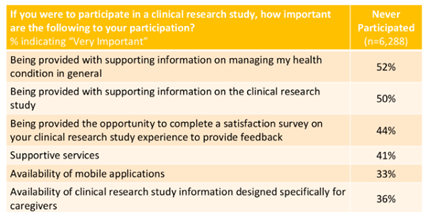Recruiting individuals for a clinical trial is usually cited as the top objective for sites, sponsors and CROs, and for good reason. The sooner a trial enrolls, the quicker data is collected, analyzed, and if successful, the trial moves on to the next phase.
However, with so much focus on patient recruitment, what about retaining the individuals who participate in a study? Once people begin their participation in a trial, they begin to realize the time, effort and attention that the study protocol requires of them. And this can be surprising to new participants, no matter how much effort was expended providing them with accurate and clear information during the recruitment process. Even the most motivated and committed participant needs support to stay in the trial.
How do we ensure that every participant doesn’t just enroll, but stays in for the life of the study?
CISCRP has extensively documented that being informed of study details and being provided with supportive services while the study plays out, such as financial reimbursement, travel concierge and rideshare, are valued by those considering participating in research – across all therapeutic areas.
Interestingly, the last Perceptions and Insights Survey from CISCRP documented that these resources were more likely to be reported as “very important” by historically underrepresented populations, including those of Hispanic and African American backgrounds. (Source – link to 2021 CISCRP site)
Both the clinical trial industry and FDA have progressed in their advocacy and adoption of patient retention tools. For example, in a 2023 Greenphire Patient Convenience Market Trends Survey, 95% of sponsors and CROs agree that removing financial and logistical barriers from patient participation in clinical trials are important targets for improving retention. Additionally, in the United States, the FDA has now issued draft guidance requiring sponsors to have diversity action plans, demonstrating their commitment to reducing burdens due to trial/study design/conduct.
A Day In the Life – An Ideal Patient Experience
The goal for a patient convenience program and more specifically, patient-centered technology, should be to remove burdens for patients and research staff, including easy access to tools for data collection, support, communication, monitoring, etc. – with the ability to be used both at home and in the clinic. It should be emphasized that it is essential that the patient experience and the site administrative experience be designed together, to ensure that innovations intended to reduce patient burden can be easily maintained by research staff. In current trial designs, more endpoints are being collected than ever before, and this can mean a need for facilitating more visits and remote data collection than ever.
With wider access to the internet and mobile devices across population sectors, investment in new technologies that ride on these channels can be expected to improve the patient experience, simplifying digital data collection, improving engagement, supporting study adherence and accelerating study timelines.
Let’s walk through the following scenario depicting how technology can support and enhance a patient’s healthcare journey…
Let’s consider the hypothetical case of a person named Cameron, who has just been diagnosed with diabetes. Though Cameron hadn’t been feeling well, he was surprised at the diagnosis and searched online for answers and support from others who live with the chronic condition.
- Patient Registry: Cameron finds an online community by a reputable foundation, which offers members trustworthy insights, asks for his input and provides information on new research studies for therapeutic treatments of diabetes. Foundations like these typically have a mission to promote research toward treatments and cures – identifying people like Cameron as being very important in that endeavor. As such, this particular Foundation utilizes a registry tool to engage and support its members. Through the application’s trial matching feature, Cameron is provided with information on several trials based on his condition and medical history.
Cameron enrolls in one of the clinical research studies presented to him through the registry tool and is excited to have the opportunity to contribute to the development of a new treatment that could help him, and others like him. The protocol includes frequent trips to the clinic as well as completion of digital trackers or e-diaries at home to regularly document how he’s feeling and track his medications. He is relieved to find that he has an app designed to help him navigate these requirements.
- Digital Access: As part of his enrollment, Cameron is invited to register for a mobile/web application where all of his study information will be made available to him after he logs in with his email address or with face/fingerprint recognition on his mobile phone. The lay out of the app is intuitive with similar functionality and navigation to other apps and websites he uses in his daily life, and so he’s in familiar territory.
Now that Cameron is enrolled, his visits have been scheduled, and he can see them laid out in his app. Having a clear view of this visit schedule allows him to plan around his other life activities. CISCRP has documented that the act of getting to and from the study clinic is a top area of burden and frustration. To alleviate this anxiety and financial impact, the study Cameron is enrolled in has enabled travel services for all study participants. This is highly appreciated by Cameron as he lives 45 miles away from the study site and living in the city, he doesn’t own a car.
- Digital Reminders: Cameron has a visit scheduled for 10am next week. His application sends a reminder the day before, to let him know the time and location of the upcoming visit. He also sees other important information: he is reminded that he should not eat the morning of the visit, so his blood tests are accurate. He is also reminded of how long he can expect the visit to last. This makes the visit more predictable and manageable. He can also share key details about each visit with friends and family to keep them up to date.
- Rideshare Itinerary: A round-trip ride for the visit has been scheduled for Cameron with a local well-known rideshare company. He can consult the details of the ride in his app, and he also gets a notification updating him about when the car will arrive. He can also request changes in itinerary if his situation changes – for example, he decides to stay with a friend for a few days and needs to be picked up from that address. With a car on the way, Cameron has no need to rely on a caregiver or friend or figure out how and when to arrange transportation himself.
The visit takes place. Being supported and informed before, during, and after the process, Cameron feels more confident in his ability to carry through with his participation in the study. When Cameron leaves the clinic, it’s dinner time, and he decides to get a meal before his return home.
- Reimbursements: After the visit, Cameron stops for dinner. Even though his next visit isn’t for more than a month, he remembers the study coordinator mentioning that he can submit receipts for reimbursement right away. He uses his app to take a photo of the receipt while sitting in the restaurant and submits it for approval and reimbursement – all done! One less piece of paper to keep track of and one less thing to remember to do.
While Cameron returns to his busy life, he can settle into the daily task of entering his information into his trackers, documenting any symptoms and tracking his medications. He can use the app to do this at a time that suits him each day. He knows that doing this task is essential for the success of the trial and the possible benefit that may result. But this is easier than he expected because the trackers are designed specifically for his condition and his trial.
- Trackers: Included in the app is a symptom tracker, customized by the study sponsor for diabetes symptoms and this trial. Cameron doesn’t find it easy to talk about his symptoms to anyone, but the tracker allows him to clearly communicate his experiences when they happen, and he likes that he can unload this uncomfortable information in real-time. He can even download the symptom report and share it with his primary care physician, giving his doctor much more information than he could before. f
- Data-driven micropayments: It turns out that the study which Cameron is enrolled in has enabled both reminders to complete assessments and facilitates a $5 stipend for time he enters data. The combination of reminders and payments increases the likelihood of data collection.
Like most people with ongoing health conditions and other stressors, with support, Cameron is quite capable of living a full and enjoyable life. Though he’s spending time adhering to the study protocol, he likes the flexibility of at-home data collection, and the manageability of his in-person study visits. The study is just a part of his life, but an important part and he sometimes gets the feeling of altruistic reward that comes from finding a way to move beyond his adversity to help himself and others and make a difference.
- Payment Access & Usage: One night, Cameron is sitting on the couch at the end of the day and pulls out his phone to check his financial account balance on his app. It’s all easily accessible in one place. Given he had accumulated some funds from study participation and remembering the PI’s reminder of the importance of daily exercise, Cameron decided to purchase a pair of running shoes in support of his health journey. He uses his funds from the study participation to seamlessly make the purchase via an online store.
After Cameron successfully completes his participation in the study, he is able to stay in touch using the app, providing feedback to the researchers, hearing more about the progress and results of the study, and next steps for the study treatment. In fact, he decides to continue using that same app to stay in a registry of former study participants and will consider participating in the next phase of the study, or even a different study.
Take the Next Step: Partner with Greenphire to Empower your Patients
85% of sponsors and CROs recently surveyed by Greenphire reaffirmed that it would be beneficial to have just one provider to deliver their entire patient engagement program, including patient stipends / reimbursements; logistics; mobile access; patient feedback and more.
Greenphire offers the solutions to remove patient burden, providing a digital access point to keep participants engaged and informed throughout a trial. Additionally, our consultative services and expertise helps support sponsors and CROs in key strategic areas, including global financial management, patient concierge and engagement, regulatory and tax – all required to successfully execute a global patient convenience program. Our solutions are preferred by global sites; in a recent survey, 91% of sites reported that they are satisfied with ClinCard and that their use of patient engagement technology hinges on whether it simplifies operations for busy site staff.
You can trust our experience and commitment to innovating the entire patient journey, so you can focus on maximizing both patient recruitment and retention for your study, ultimately leading to more complete data collection, quality results and faster timelines.



